Unit V Toxicology Report: Benzene vs. Asbestos as Potent Carcinogens
VerifiedAdded on 2022/10/02
|6
|1293
|468
Report
AI Summary
This report provides a comparative analysis of benzene and asbestos, two significant carcinogens. It begins with an introduction to carcinogenic compounds and their mechanisms, highlighting the mutagenic properties of benzene and the non-mutagenic nature of asbestos. The report details the sources of exposure, primarily through inhalation, and contrasts the health effects of each substance, including the nervous system impacts of benzene and the lung-related diseases caused by asbestos. It further examines the molecular mechanisms of carcinogenicity, such as benzene's oxidation and DNA adduct formation, and asbestos's direct irritation of lung cells. The report also discusses the different types of cancers associated with each carcinogen, such as leukemia from benzene exposure and lung cancer or mesothelioma from asbestos exposure. It concludes by emphasizing the ongoing risks associated with benzene exposure and the reduced, but still present, risks associated with asbestos exposure, referencing relevant research and studies.
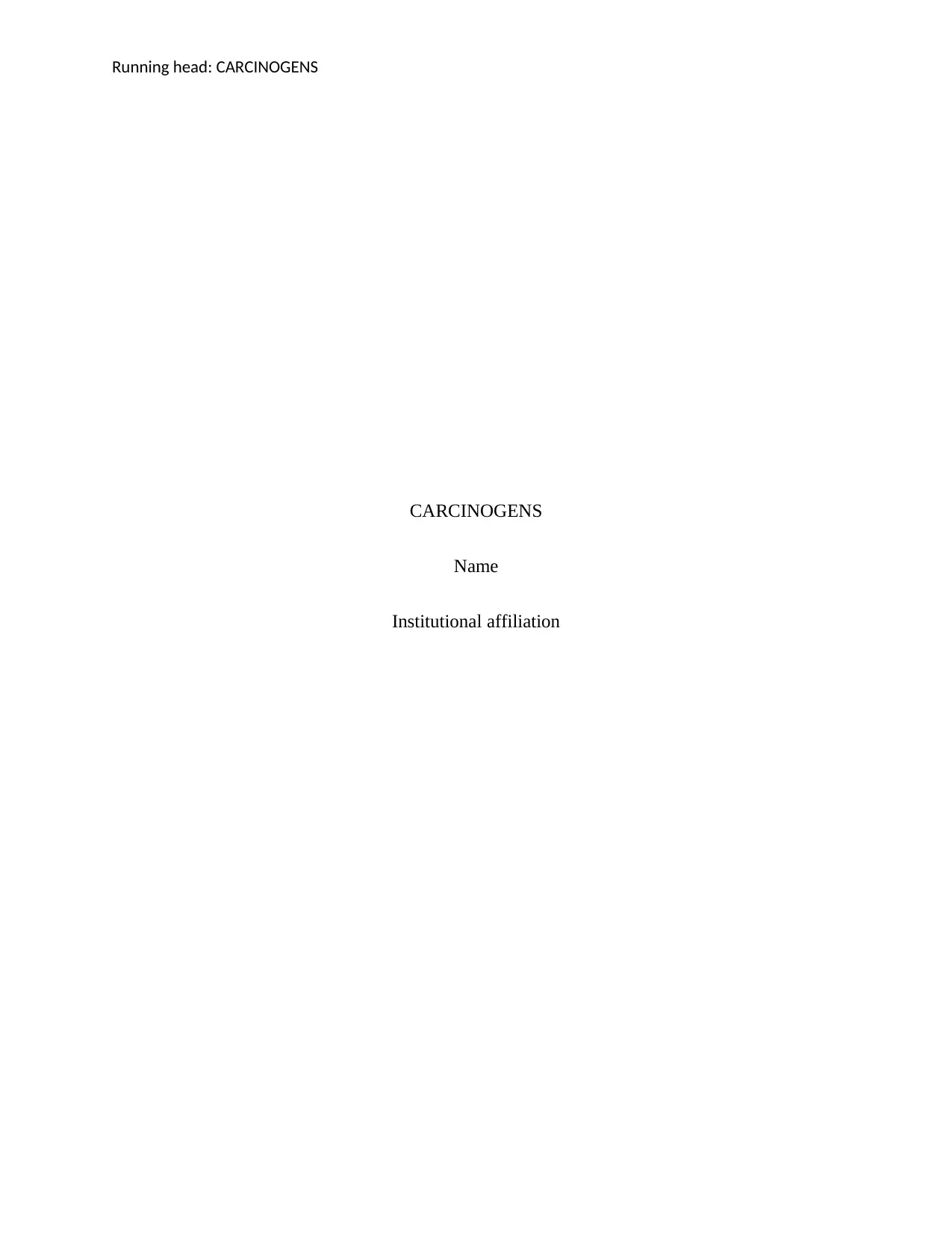
Running head: CARCINOGENS
CARCINOGENS
Name
Institutional affiliation
CARCINOGENS
Name
Institutional affiliation
Paraphrase This Document
Need a fresh take? Get an instant paraphrase of this document with our AI Paraphraser
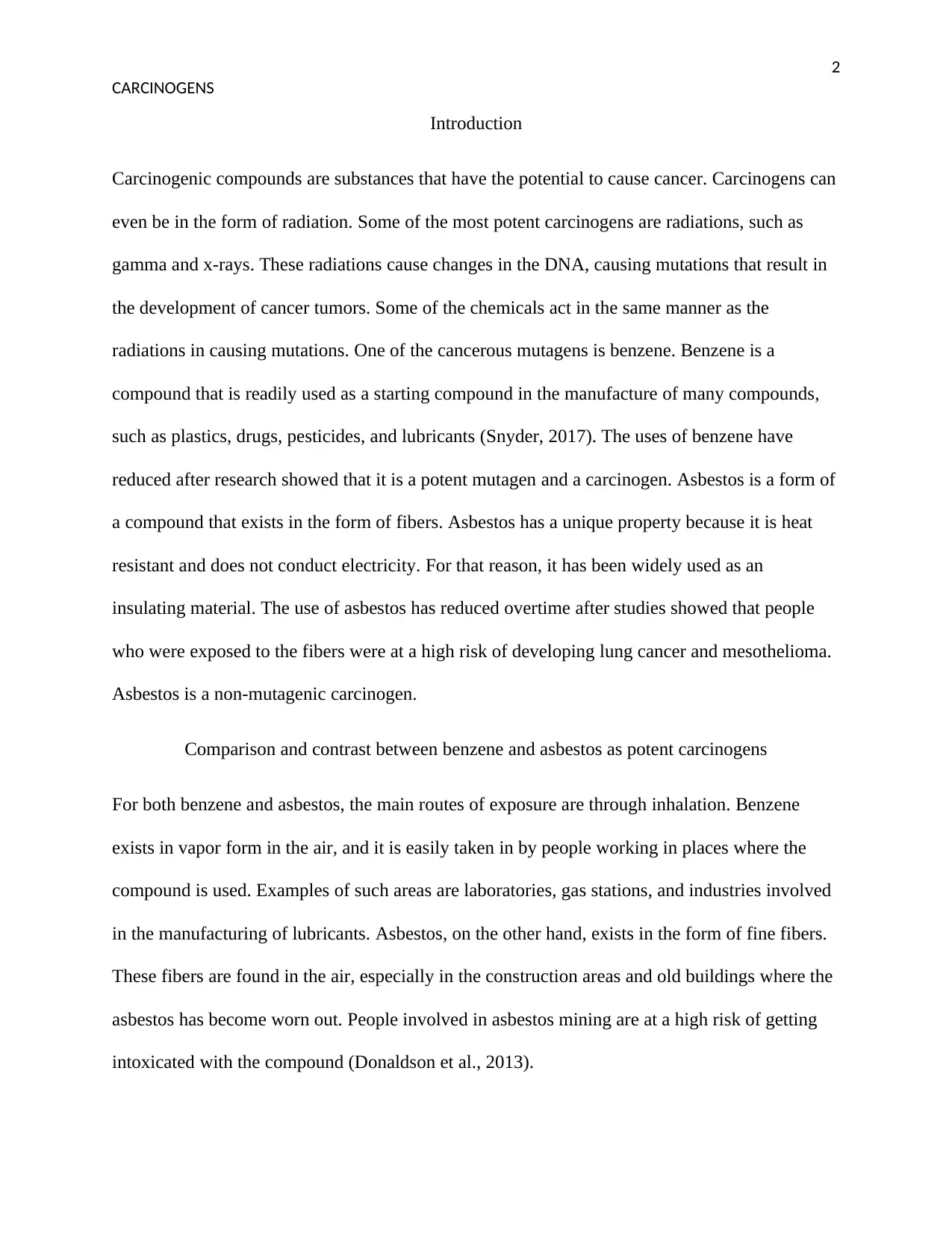
2
CARCINOGENS
Introduction
Carcinogenic compounds are substances that have the potential to cause cancer. Carcinogens can
even be in the form of radiation. Some of the most potent carcinogens are radiations, such as
gamma and x-rays. These radiations cause changes in the DNA, causing mutations that result in
the development of cancer tumors. Some of the chemicals act in the same manner as the
radiations in causing mutations. One of the cancerous mutagens is benzene. Benzene is a
compound that is readily used as a starting compound in the manufacture of many compounds,
such as plastics, drugs, pesticides, and lubricants (Snyder, 2017). The uses of benzene have
reduced after research showed that it is a potent mutagen and a carcinogen. Asbestos is a form of
a compound that exists in the form of fibers. Asbestos has a unique property because it is heat
resistant and does not conduct electricity. For that reason, it has been widely used as an
insulating material. The use of asbestos has reduced overtime after studies showed that people
who were exposed to the fibers were at a high risk of developing lung cancer and mesothelioma.
Asbestos is a non-mutagenic carcinogen.
Comparison and contrast between benzene and asbestos as potent carcinogens
For both benzene and asbestos, the main routes of exposure are through inhalation. Benzene
exists in vapor form in the air, and it is easily taken in by people working in places where the
compound is used. Examples of such areas are laboratories, gas stations, and industries involved
in the manufacturing of lubricants. Asbestos, on the other hand, exists in the form of fine fibers.
These fibers are found in the air, especially in the construction areas and old buildings where the
asbestos has become worn out. People involved in asbestos mining are at a high risk of getting
intoxicated with the compound (Donaldson et al., 2013).
CARCINOGENS
Introduction
Carcinogenic compounds are substances that have the potential to cause cancer. Carcinogens can
even be in the form of radiation. Some of the most potent carcinogens are radiations, such as
gamma and x-rays. These radiations cause changes in the DNA, causing mutations that result in
the development of cancer tumors. Some of the chemicals act in the same manner as the
radiations in causing mutations. One of the cancerous mutagens is benzene. Benzene is a
compound that is readily used as a starting compound in the manufacture of many compounds,
such as plastics, drugs, pesticides, and lubricants (Snyder, 2017). The uses of benzene have
reduced after research showed that it is a potent mutagen and a carcinogen. Asbestos is a form of
a compound that exists in the form of fibers. Asbestos has a unique property because it is heat
resistant and does not conduct electricity. For that reason, it has been widely used as an
insulating material. The use of asbestos has reduced overtime after studies showed that people
who were exposed to the fibers were at a high risk of developing lung cancer and mesothelioma.
Asbestos is a non-mutagenic carcinogen.
Comparison and contrast between benzene and asbestos as potent carcinogens
For both benzene and asbestos, the main routes of exposure are through inhalation. Benzene
exists in vapor form in the air, and it is easily taken in by people working in places where the
compound is used. Examples of such areas are laboratories, gas stations, and industries involved
in the manufacturing of lubricants. Asbestos, on the other hand, exists in the form of fine fibers.
These fibers are found in the air, especially in the construction areas and old buildings where the
asbestos has become worn out. People involved in asbestos mining are at a high risk of getting
intoxicated with the compound (Donaldson et al., 2013).
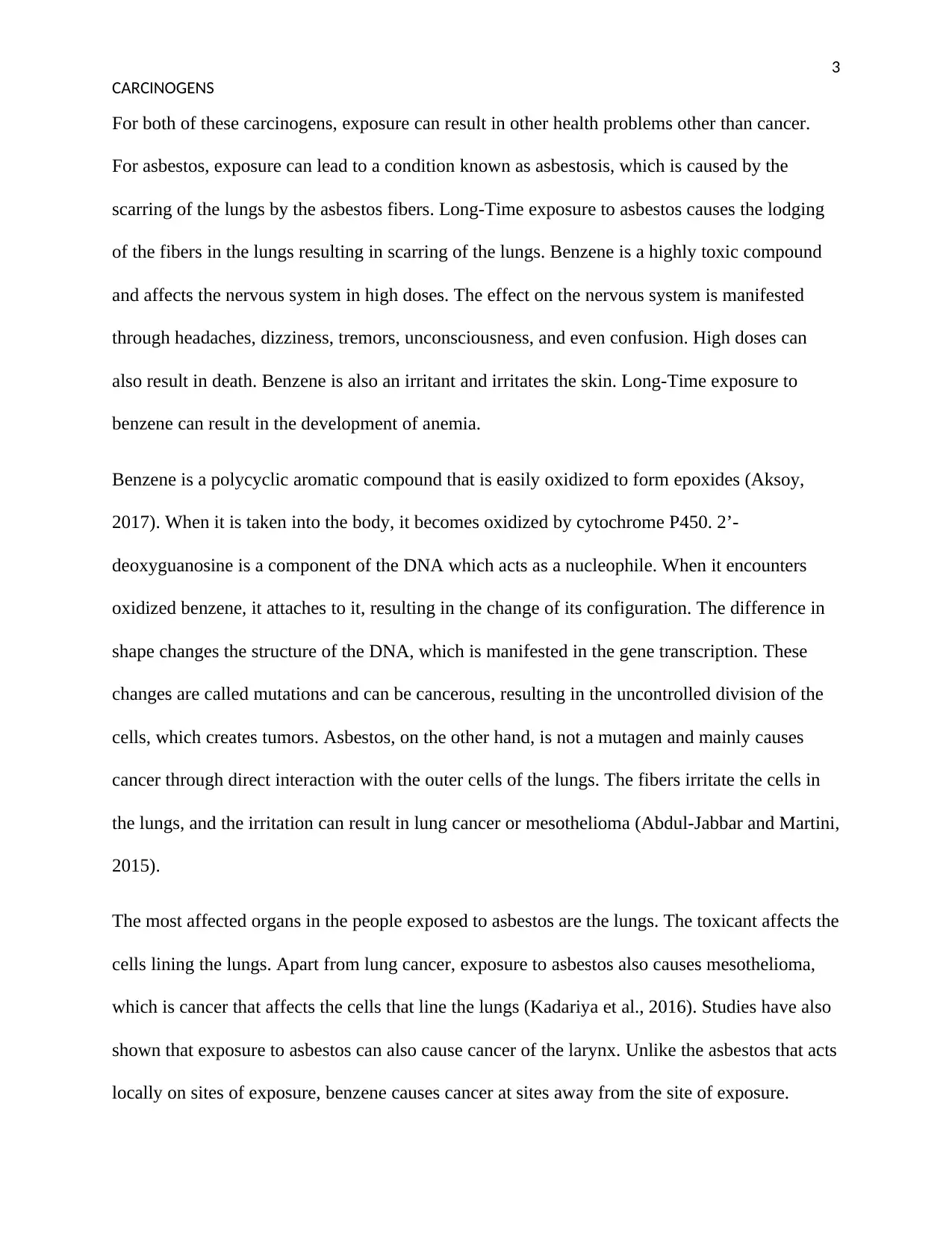
3
CARCINOGENS
For both of these carcinogens, exposure can result in other health problems other than cancer.
For asbestos, exposure can lead to a condition known as asbestosis, which is caused by the
scarring of the lungs by the asbestos fibers. Long-Time exposure to asbestos causes the lodging
of the fibers in the lungs resulting in scarring of the lungs. Benzene is a highly toxic compound
and affects the nervous system in high doses. The effect on the nervous system is manifested
through headaches, dizziness, tremors, unconsciousness, and even confusion. High doses can
also result in death. Benzene is also an irritant and irritates the skin. Long-Time exposure to
benzene can result in the development of anemia.
Benzene is a polycyclic aromatic compound that is easily oxidized to form epoxides (Aksoy,
2017). When it is taken into the body, it becomes oxidized by cytochrome P450. 2’-
deoxyguanosine is a component of the DNA which acts as a nucleophile. When it encounters
oxidized benzene, it attaches to it, resulting in the change of its configuration. The difference in
shape changes the structure of the DNA, which is manifested in the gene transcription. These
changes are called mutations and can be cancerous, resulting in the uncontrolled division of the
cells, which creates tumors. Asbestos, on the other hand, is not a mutagen and mainly causes
cancer through direct interaction with the outer cells of the lungs. The fibers irritate the cells in
the lungs, and the irritation can result in lung cancer or mesothelioma (Abdul-Jabbar and Martini,
2015).
The most affected organs in the people exposed to asbestos are the lungs. The toxicant affects the
cells lining the lungs. Apart from lung cancer, exposure to asbestos also causes mesothelioma,
which is cancer that affects the cells that line the lungs (Kadariya et al., 2016). Studies have also
shown that exposure to asbestos can also cause cancer of the larynx. Unlike the asbestos that acts
locally on sites of exposure, benzene causes cancer at sites away from the site of exposure.
CARCINOGENS
For both of these carcinogens, exposure can result in other health problems other than cancer.
For asbestos, exposure can lead to a condition known as asbestosis, which is caused by the
scarring of the lungs by the asbestos fibers. Long-Time exposure to asbestos causes the lodging
of the fibers in the lungs resulting in scarring of the lungs. Benzene is a highly toxic compound
and affects the nervous system in high doses. The effect on the nervous system is manifested
through headaches, dizziness, tremors, unconsciousness, and even confusion. High doses can
also result in death. Benzene is also an irritant and irritates the skin. Long-Time exposure to
benzene can result in the development of anemia.
Benzene is a polycyclic aromatic compound that is easily oxidized to form epoxides (Aksoy,
2017). When it is taken into the body, it becomes oxidized by cytochrome P450. 2’-
deoxyguanosine is a component of the DNA which acts as a nucleophile. When it encounters
oxidized benzene, it attaches to it, resulting in the change of its configuration. The difference in
shape changes the structure of the DNA, which is manifested in the gene transcription. These
changes are called mutations and can be cancerous, resulting in the uncontrolled division of the
cells, which creates tumors. Asbestos, on the other hand, is not a mutagen and mainly causes
cancer through direct interaction with the outer cells of the lungs. The fibers irritate the cells in
the lungs, and the irritation can result in lung cancer or mesothelioma (Abdul-Jabbar and Martini,
2015).
The most affected organs in the people exposed to asbestos are the lungs. The toxicant affects the
cells lining the lungs. Apart from lung cancer, exposure to asbestos also causes mesothelioma,
which is cancer that affects the cells that line the lungs (Kadariya et al., 2016). Studies have also
shown that exposure to asbestos can also cause cancer of the larynx. Unlike the asbestos that acts
locally on sites of exposure, benzene causes cancer at sites away from the site of exposure.
⊘ This is a preview!⊘
Do you want full access?
Subscribe today to unlock all pages.

Trusted by 1+ million students worldwide
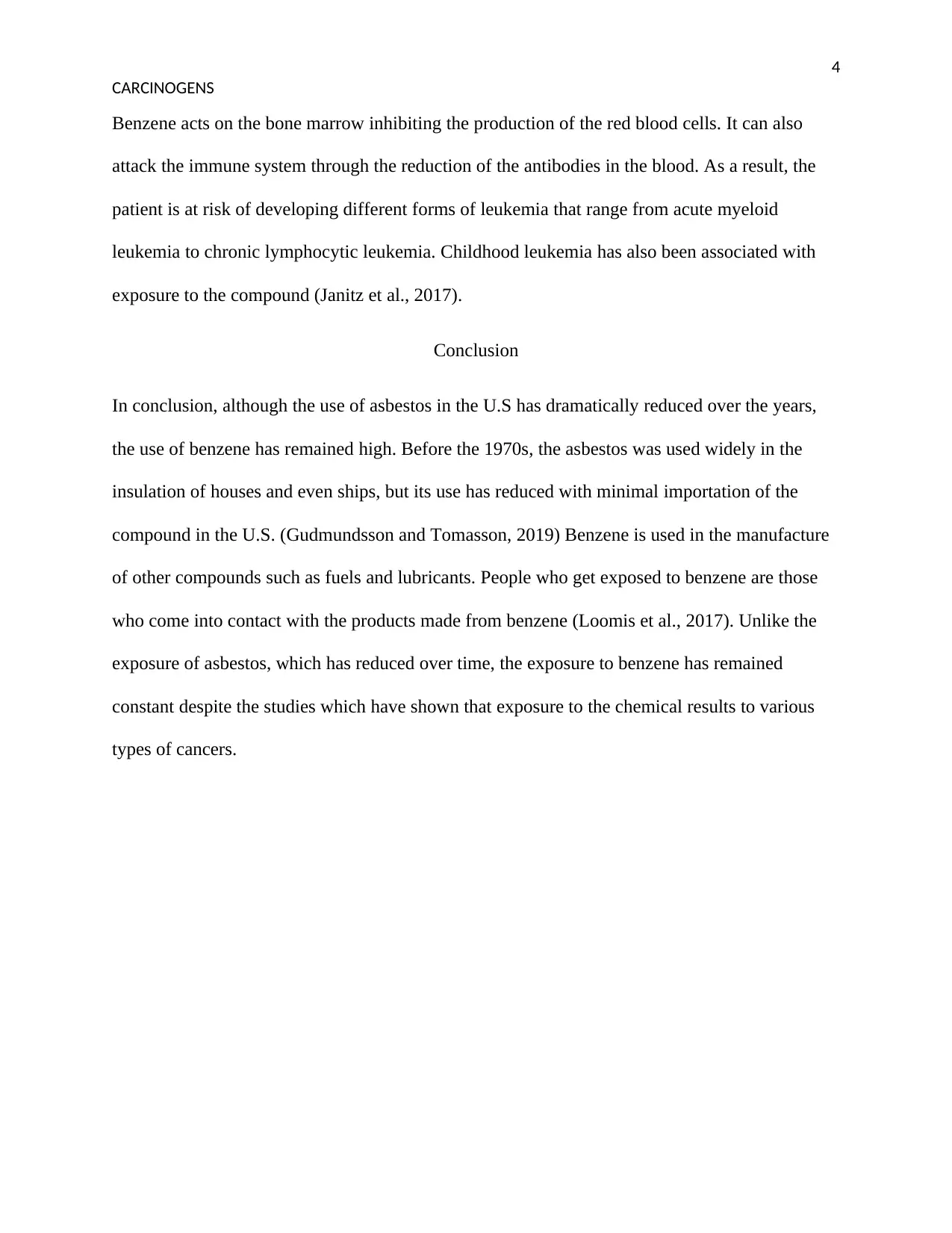
4
CARCINOGENS
Benzene acts on the bone marrow inhibiting the production of the red blood cells. It can also
attack the immune system through the reduction of the antibodies in the blood. As a result, the
patient is at risk of developing different forms of leukemia that range from acute myeloid
leukemia to chronic lymphocytic leukemia. Childhood leukemia has also been associated with
exposure to the compound (Janitz et al., 2017).
Conclusion
In conclusion, although the use of asbestos in the U.S has dramatically reduced over the years,
the use of benzene has remained high. Before the 1970s, the asbestos was used widely in the
insulation of houses and even ships, but its use has reduced with minimal importation of the
compound in the U.S. (Gudmundsson and Tomasson, 2019) Benzene is used in the manufacture
of other compounds such as fuels and lubricants. People who get exposed to benzene are those
who come into contact with the products made from benzene (Loomis et al., 2017). Unlike the
exposure of asbestos, which has reduced over time, the exposure to benzene has remained
constant despite the studies which have shown that exposure to the chemical results to various
types of cancers.
CARCINOGENS
Benzene acts on the bone marrow inhibiting the production of the red blood cells. It can also
attack the immune system through the reduction of the antibodies in the blood. As a result, the
patient is at risk of developing different forms of leukemia that range from acute myeloid
leukemia to chronic lymphocytic leukemia. Childhood leukemia has also been associated with
exposure to the compound (Janitz et al., 2017).
Conclusion
In conclusion, although the use of asbestos in the U.S has dramatically reduced over the years,
the use of benzene has remained high. Before the 1970s, the asbestos was used widely in the
insulation of houses and even ships, but its use has reduced with minimal importation of the
compound in the U.S. (Gudmundsson and Tomasson, 2019) Benzene is used in the manufacture
of other compounds such as fuels and lubricants. People who get exposed to benzene are those
who come into contact with the products made from benzene (Loomis et al., 2017). Unlike the
exposure of asbestos, which has reduced over time, the exposure to benzene has remained
constant despite the studies which have shown that exposure to the chemical results to various
types of cancers.
Paraphrase This Document
Need a fresh take? Get an instant paraphrase of this document with our AI Paraphraser
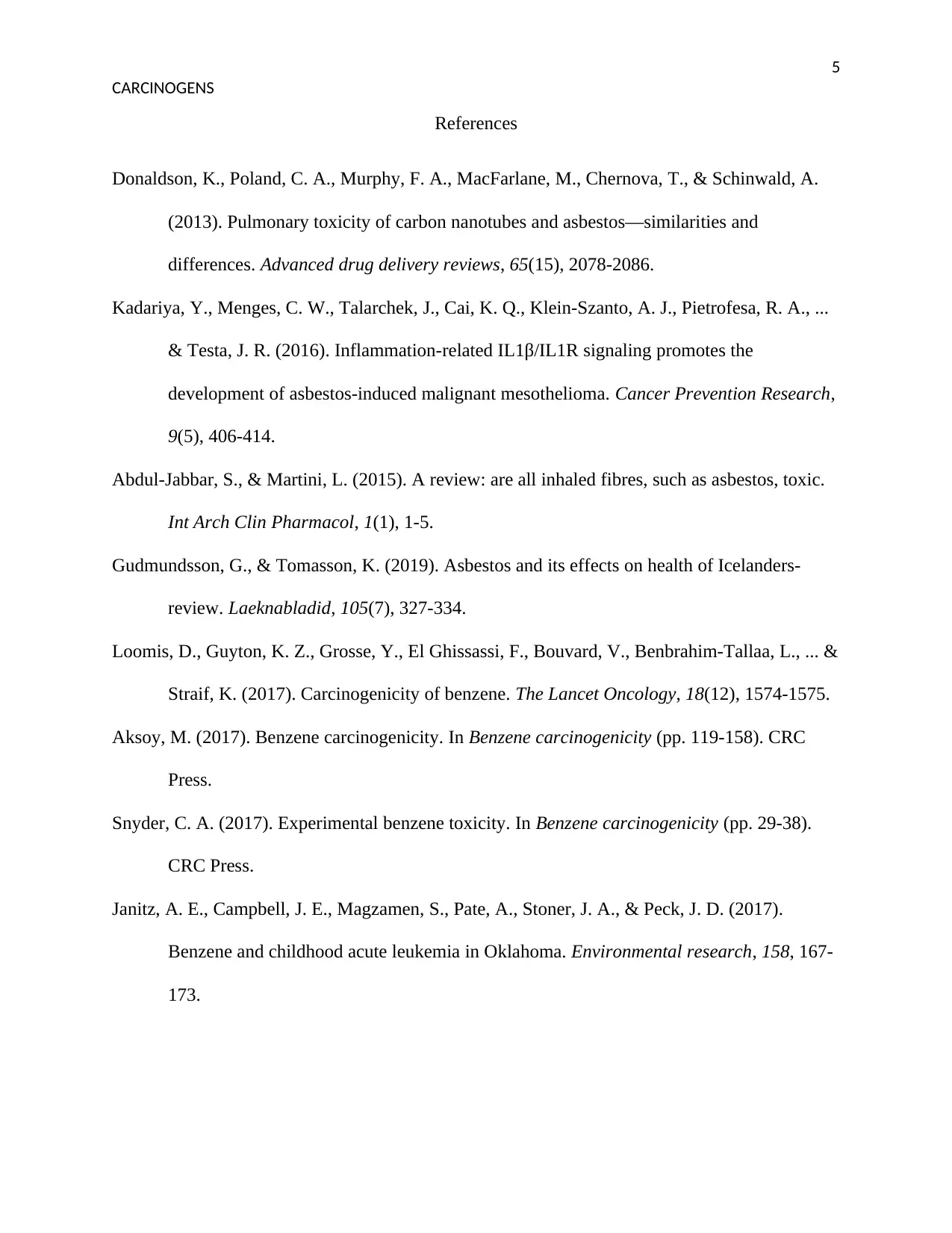
5
CARCINOGENS
References
Donaldson, K., Poland, C. A., Murphy, F. A., MacFarlane, M., Chernova, T., & Schinwald, A.
(2013). Pulmonary toxicity of carbon nanotubes and asbestos—similarities and
differences. Advanced drug delivery reviews, 65(15), 2078-2086.
Kadariya, Y., Menges, C. W., Talarchek, J., Cai, K. Q., Klein-Szanto, A. J., Pietrofesa, R. A., ...
& Testa, J. R. (2016). Inflammation-related IL1β/IL1R signaling promotes the
development of asbestos-induced malignant mesothelioma. Cancer Prevention Research,
9(5), 406-414.
Abdul-Jabbar, S., & Martini, L. (2015). A review: are all inhaled fibres, such as asbestos, toxic.
Int Arch Clin Pharmacol, 1(1), 1-5.
Gudmundsson, G., & Tomasson, K. (2019). Asbestos and its effects on health of Icelanders-
review. Laeknabladid, 105(7), 327-334.
Loomis, D., Guyton, K. Z., Grosse, Y., El Ghissassi, F., Bouvard, V., Benbrahim-Tallaa, L., ... &
Straif, K. (2017). Carcinogenicity of benzene. The Lancet Oncology, 18(12), 1574-1575.
Aksoy, M. (2017). Benzene carcinogenicity. In Benzene carcinogenicity (pp. 119-158). CRC
Press.
Snyder, C. A. (2017). Experimental benzene toxicity. In Benzene carcinogenicity (pp. 29-38).
CRC Press.
Janitz, A. E., Campbell, J. E., Magzamen, S., Pate, A., Stoner, J. A., & Peck, J. D. (2017).
Benzene and childhood acute leukemia in Oklahoma. Environmental research, 158, 167-
173.
CARCINOGENS
References
Donaldson, K., Poland, C. A., Murphy, F. A., MacFarlane, M., Chernova, T., & Schinwald, A.
(2013). Pulmonary toxicity of carbon nanotubes and asbestos—similarities and
differences. Advanced drug delivery reviews, 65(15), 2078-2086.
Kadariya, Y., Menges, C. W., Talarchek, J., Cai, K. Q., Klein-Szanto, A. J., Pietrofesa, R. A., ...
& Testa, J. R. (2016). Inflammation-related IL1β/IL1R signaling promotes the
development of asbestos-induced malignant mesothelioma. Cancer Prevention Research,
9(5), 406-414.
Abdul-Jabbar, S., & Martini, L. (2015). A review: are all inhaled fibres, such as asbestos, toxic.
Int Arch Clin Pharmacol, 1(1), 1-5.
Gudmundsson, G., & Tomasson, K. (2019). Asbestos and its effects on health of Icelanders-
review. Laeknabladid, 105(7), 327-334.
Loomis, D., Guyton, K. Z., Grosse, Y., El Ghissassi, F., Bouvard, V., Benbrahim-Tallaa, L., ... &
Straif, K. (2017). Carcinogenicity of benzene. The Lancet Oncology, 18(12), 1574-1575.
Aksoy, M. (2017). Benzene carcinogenicity. In Benzene carcinogenicity (pp. 119-158). CRC
Press.
Snyder, C. A. (2017). Experimental benzene toxicity. In Benzene carcinogenicity (pp. 29-38).
CRC Press.
Janitz, A. E., Campbell, J. E., Magzamen, S., Pate, A., Stoner, J. A., & Peck, J. D. (2017).
Benzene and childhood acute leukemia in Oklahoma. Environmental research, 158, 167-
173.

6
CARCINOGENS
CARCINOGENS
⊘ This is a preview!⊘
Do you want full access?
Subscribe today to unlock all pages.

Trusted by 1+ million students worldwide
1 out of 6
Your All-in-One AI-Powered Toolkit for Academic Success.
+13062052269
info@desklib.com
Available 24*7 on WhatsApp / Email
![[object Object]](/_next/static/media/star-bottom.7253800d.svg)
Unlock your academic potential
Copyright © 2020–2025 A2Z Services. All Rights Reserved. Developed and managed by ZUCOL.

